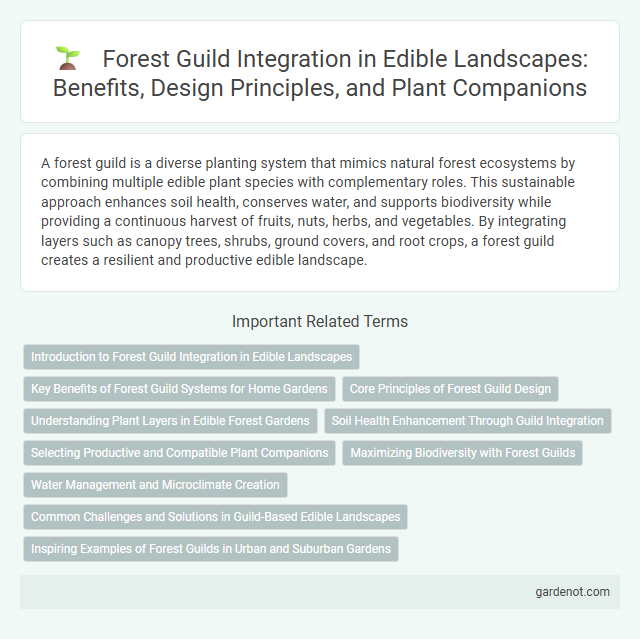A forest guild is a diverse planting system that mimics natural forest ecosystems by combining multiple edible plant species with complementary roles. This sustainable approach enhances soil health, conserves water, and supports biodiversity while providing a continuous harvest of fruits, nuts, herbs, and vegetables. By integrating layers such as canopy trees, shrubs, ground covers, and root crops, a forest guild creates a resilient and productive edible landscape.
Introduction to Forest Guild Integration in Edible Landscapes
Forest guild integration in edible landscapes involves strategically planting a diverse group of species that support each other's growth and productivity. This method mimics natural forest ecosystems by combining trees, shrubs, herbs, and ground covers, enhancing soil health, pest control, and nutrient cycling. Incorporating nitrogen-fixing plants, dynamic accumulators, and pollinator-friendly species creates a resilient and self-sustaining food system.
Key Benefits of Forest Guild Systems for Home Gardens
Forest guild systems enhance home gardens by promoting biodiversity, improving soil health through natural nutrient cycling, and supporting pollinators vital for fruit and vegetable production. These systems create resilient ecosystems that reduce pest outbreaks and minimize the need for chemical inputs, fostering sustainable food production. Integrating diverse species in forest guilds also increases overall yield and provides multiple harvests throughout the growing season.
Core Principles of Forest Guild Design
Forest guild design centers on creating a resilient, self-sustaining ecosystem by integrating diverse plant species that fulfill complementary roles such as nitrogen fixation, ground cover, and pest repellence. Core principles emphasize vertical layering with canopy trees, understory shrubs, herbaceous plants, groundcovers, and root crops to maximize space and resource use. Biodiversity, soil health, and water conservation are fundamental to supporting beneficial wildlife and enhancing overall landscape productivity.
Understanding Plant Layers in Edible Forest Gardens
Forest guilds in edible forest gardens mimic natural ecosystems by organizing plants into specific layers such as canopy trees, understory trees, shrubs, herbs, groundcovers, root crops, and vines. Each plant layer serves distinct ecological functions like nitrogen fixation, pest control, or pollinator attraction, promoting biodiversity and resilient food production. Understanding these plant layers enhances soil health, maximizes space, and supports sustainable yields in permaculture design.
Soil Health Enhancement Through Guild Integration
Forest guild integration significantly enhances soil health by promoting diverse root structures that improve aeration and water retention. The symbiotic relationships between nitrogen-fixing plants, mycorrhizal fungi, and nutrient-accumulating species increase organic matter and nutrient cycling efficiency. This cooperative plant network reduces erosion, fosters microbial biodiversity, and creates a resilient, self-sustaining soil ecosystem.
Selecting Productive and Compatible Plant Companions
Selecting productive and compatible plant companions in a forest guild involves integrating nitrogen-fixing species like clover or alder to enhance soil fertility naturally. Shade-tolerant perennials such as medicinal herbs and berries thrive alongside taller fruit and nut trees, creating a layered ecosystem that maximizes space and yields. Careful attention to root depth and nutrient needs prevents competition, ensuring each plant supports the guild's overall health and productivity.
Maximizing Biodiversity with Forest Guilds
Forest guilds maximize biodiversity by combining complementary plant species that support each other's growth and attract a variety of wildlife, enhancing ecosystem resilience. Key species include nitrogen-fixing trees, fruit-bearing shrubs, and ground covers that improve soil health and habitat complexity. This layered planting strategy creates a self-sustaining edible landscape rich in resources for pollinators, birds, and beneficial insects.
Water Management and Microclimate Creation
Forest guilds enhance water management by integrating deep-rooted trees and water-retentive plants that improve soil infiltration and reduce runoff. These diverse plant layers create microclimates by providing shade, reducing wind speed, and maintaining humidity, which supports a stable environment for aquatic and terrestrial species. Optimized water cycles and moderated temperatures promote resilient, productive edible landscapes with sustained growth and biodiversity.
Common Challenges and Solutions in Guild-Based Edible Landscapes
Forest guilds in edible landscapes often face challenges such as competition for resources, pest management, and maintaining soil fertility. Effective solutions include selecting complementary plant species with varied root depths, using companion planting to deter pests naturally, and incorporating nitrogen-fixing plants to enhance soil nutrients. Implementing mulch layers and dynamic accumulators further supports soil health and moisture retention within the guild.
Inspiring Examples of Forest Guilds in Urban and Suburban Gardens
Forest guilds in urban and suburban gardens showcase diverse plant species that function symbiotically to enhance soil fertility, support pollinators, and provide edible harvests. Examples such as the Three Sisters guild combine corn, beans, and squash, promoting mutual growth and maximizing space efficiency while offering nutritious food sources. Innovative designs integrate nitrogen-fixing trees, perennial herbs, and berry-producing shrubs to create resilient ecosystems that thrive in limited urban environments.
Forest guild Infographic

 gardenot.com
gardenot.com